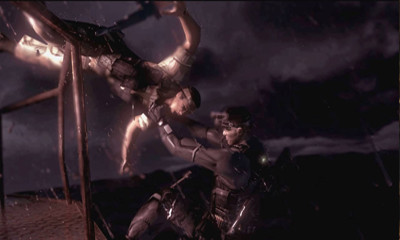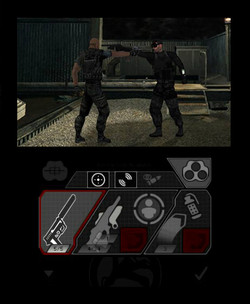As with the recently reviewed Rayman 3D, Splinter Cell 3D, another of Ubisoft's launch titles for the 3DS, isn't actually an entirely new game. Instead, this is a slightly updated version of 2005's Splinter Cell: Chaos Theory, which was released on pretty much every platform under the sun at that time. Rather than a straight copy, however, what we have here is actually a stripped down version of the original game, comprised only of the single player mode, missing out the original's multiplayer, and co-operative storyline altogether. It's a bit of a missed opportunity, to say the least, as it could have been a great early demonstration of the 3DS's wireless capabilities, and would have given people an extra reason to buy the game.
In Splinter Cell 3D, you play as Sam Fisher, Tom Clancy's favourite secret agent, as you're plunged into a world of espionage and dodgy governments, as you try to prevent some stolen algorithms from being used to trigger a war in the East. Rather than just James Bond-ing it up, however, and blowing everything that's in sight to smithereens before escaping with a lady on the back of hang glider powered by a hi-tech watch, the action in Splinter Cell is a lot slower. Here, the emphasis is on staying out of sight, creeping about in the shadows, and doing whatever you need to do to complete your mission - quietly.

Listen to the giant text - it speaks the truth!
The amount of light, and the amount of noise you're making are the key things you need to keep in mind as you lurk through Splinter Cell's levels - and, thankfully, the game gives you plenty of warning when you start to put a foot wrong, thanks to two bars at the top of the screen. The first, on the left of the screen, tells you how bright the area you're currently standing in is - with an empty bar, enemies will walk right past you without seeing you - but if it's full, or even beginning to fill up, you may well find yourself being collared by the bad guys. The second bar, on the other hand, shows how much noise you're making as compared to the background noise. Stomp around in your giant, military issue boots, and you can be sure of a rude welcoming from the guards - instead, it's important to move slowly, carefully, and cautiously.
Of course, this would be a lot easier to do if you could actually see where you're going. One of the biggest problems with Splinter Cell 3D is with the visuals, as everything's just so, so dark. With a pallet of colours ranging from "mud brown" to "cosmic black", everything's dark enough to begin with, yet alone when you take into account how washed out the screen looks the second any light hits your 3DS's screen. With no way to adjust the brightness, which is a ridiculous oversight in a game like this, you'll be wanting to draw the curtains, and skulk in the shadows in real life if you want to play this. Things are only made worse by the camera/gun aiming controls, which ask you to press the A,B,X and Y buttons, to move the camera up, down, left and right, which, sadly, doesn't really offer the precision you need for a game like this. Trying to take an enemy out quietly when you just end up shooting either side of his head because the camera controls are so jumpy makes things more awkward than they should be.
Similarly strange for a handheld game is the reliance on sound. You'll hear enemies moving, and talking, long before you see them, so keeping an ear out is incredibly important (especially as, annoyingly, there are no subtitles for conversations between guards) - which means you'll have to play with the sound up, or headphones in - again, not very practical for a console that's meant to be portable.
Thankfully, though, what Splinter Cell 3D lacks in common sense, and previously-included multiplayer options, it more than makes up for in terms of its gameplay. We're actually not usually huge fans of stealth gameplay, as far too often, it's simply an awkward and frustrating experience, as a bad guy spots you, and shoots you dead before you've even had chance to pretend you'd just managed to get lost. In Splinter Cell 3D, however, the missions are so varied, and infused with spy-thriller action, that things are always exciting.

You're coming with me...
Whether you're rappelling into a bank, Mission Impossible style, or waiting behind a door until a guard goes past, giving you chance to slink into the next room, Splinter Cell 3D can be a genuine thriller, with plenty of heart-in-mouth moments as you go about your spy duties - and there's usually time to rectify a situation, even if it goes wrong. As a master of hand to hand combat, all you have to do is press the left bumper near an enemy, and Sam will knock them out, meaning all that's left for you to do is to put the body somewhere no-one'll find it, and skulk off before they come to and wonder why their head hurts.
It's an intelligent game, and there's a lot to think about if you don't want to get discovered. From security cameras adorning walls (which really need to be easier to spot, as the only warning you get is an audible whirring, again, mostly useless for a handheld game), to guards patrolling corridors, looking for the intruder (you), you'll have to plan your actions through each room meticulously, and make sure you've got a contingency plan for when things go wrong.

Our money's on Sam.
As an example of a time where you really have to use your brain, during the second level, we were infiltrating a ship, and started to approach the engine room. As we were going down the stairs, a message came over our headset from our base, warning us that there was a gas leak in the engine room - and that, as such, we shouldn't use our guns. Any shots could set off an explosion - and, as our base warned, we shouldn't expect the guards to have thought this situation through like we had. Staying un-noticed here was key - there'd be no chance for a contingency plan if we found ourselves in the firing line. Pressing left on the +Control Pad, we pressed ourselves against the wall, and slowly approached the open door to the engine room, watching the guards go about their patrols - two on the floor, one in the roof walking across an elevated walkway. We went through our options in our head, but many of them wouldn't work here. If it weren't for the gas leak, we could toss a grenade in there, and take out two of the guards - or a flash bang, letting us take advantage of the confusion to clear a path through the room.
If we wanted to lure them out, we could whistle, to attract their attention, and then take them out when they left the engine room to find out where the strange whistling sound was coming from, but over the racket of the engines, they'd never hear us. Instead, some top class stealth was what was required here - and that's exactly what we did.
You need to watch the patterns the guards walk, and pick your moments carefully, moving in with efficiency and knocking the guard out without being spotted by one of the other two, before carrying them away, so the guards aren't alerted by the sight of their collapsed colleague. Then, all you have to do is rinse, repeat, and move on through the area.
There's a fair degree of freedom in how you approach each level, too, with many areas being part of a large, sprawling map, with interconnecting corridors, or, at least, a branching path that lets you approach from one of two areas. Taking a look around, and knowing the area is just as important as having a quick trigger finger, as this is a thinking man's shooter. Even opening a door comes with several options - do you want to open it normally; push it open gently, to give you time to see what's on the other side, and make a hasty retreat; put your optic cable underneath it, so you can see what's on the other side without even touching the door; or bash it open, to lure some guards into a trap?
As impressively thoughtful as it is, though, the stealth in Splinter Cell 3D does have its problems. There have been a few occasions where we've snuck up on sleeping enemies like a boss, only to press the left bumper to knock the guy out, and find that... nothing happens. Maybe we weren't close enough, or maybe we weren't in quite the right position, but it makes no sense that the game would give us the option to knock the bad guy out if we couldn't do it anyway. As is always the way, we then moved a little bit closer, only to end up poking the bad guy, waking him up, and finding a gun pointed in our face. Similarly, the controls can be a bit unwieldy at times, as rather than simply touching what you want to do when opening a door, you have to press an arrow to scroll through a list of items, which isn't just awkward, but also wastes precious time when a quick decision could be important.
With its secret agent vibe, and intelligent gameplay, Splinter Cell 3D is an impressive game - a fact that's made even more impressive when you consider the fact that this is effectively missing half of the content. If you've played the original, there's little point getting this unless you have an insatiable urge to play through half of the game on a handheld. For those who've never played a Splinter Cell, though, despite a few stupid decisions for a handheld game, this is a good place to start.
Format Reviewed: Nintendo 3DS
















